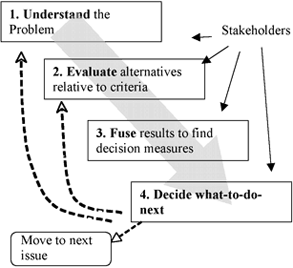Process
A process is a reusable series of steps and related practices to achieve a goal. Here are some examples:
The process of long division by hand let's you solve the problem of division.
Doctors have a standard procedure for diagnosing many types of illnesses, starting with the symptoms.
A nation's constitution specifies how a country manages itself, in order to optimize the common good of its people.
Robert’s Rules of Order specify the rules of palamentary procedure and debate, to achieve the goal of high quality decision making.
All of these are a much better way of achieving a goal than no process or the wrong process.
Why the right process is vital to successful problem solving
There's a fundamental principle at play here. It's the one we depend on the most when we start work on a tough problem:
Key Principle
Without a process that fits the problem, a problem solver working on a difficult problem faces near certain failure.
This timeless principle has been proven over and over:
It's the reason all the processes listed above are so common.
Science was not science until it had a process that fit is problem: the Scientific Method.
Business could not grow beyond a certain size and complexity until it had a process that fit its fundamental problem: how to manage the flow of money. The problem was solved by invention of a process that fit the problem: double entry accounting.
The life sciences could not become productive until Charles Darwin discovered the process of evolution. It consists of three cyclic steps: replication, mutation, and survival of the fittest.
Using the right process is so critical it's the most important step in the Analytical Method:
The Analytical Method
1. Identify the problem to solve.
2. Choose an appropriate process. (THE KEY STEP)
![]() 3. Use
the process to hypothesize analysis or solution elements.
3. Use
the process to hypothesize analysis or solution elements.
![]() 4.
Design an experiment(s) to test the hypothesis.
4.
Design an experiment(s) to test the hypothesis.
![]() 5.
Perform the experiment(s).
5.
Perform the experiment(s).
![]() 6.
Accept, reject, or modify the hypothesis.
6.
Accept, reject, or modify the hypothesis.
![]() 7.
Repeat steps 3, 4, 5, and 6 until the hypothesis
is accepted.
7.
Repeat steps 3, 4, 5, and 6 until the hypothesis
is accepted.
8. Implement the solution.
9. Continuously improve the process as opportunities arise.
Yet despite the critical importance of choosing an appropriate process, most environmental organizations do not follow a formal problem solving process to achieve their objectives. Instead, they use an intuitive approach consisting of whatever steps seem necessary at the moment. Because the process is not written down, it cannot be communicated, improved, or even followed efficiently. As a result, the process tends to never become mature enough to solve anything but easy problems.
But try to tell this to the average environmentalist or environmental CEO like I have many times, and you will get the shock of your life. Usually I get a blank stare when I ask what process are you using to solve your problems. Sometimes they do a little better. They swear they are following an appropriate process (but they really are not), or they will react as if the question doesn't matter at all, or that you've got to be kidding, we don't need a process, we know what we're doing, and so forth.
Using a process map to manage your process
A simple process can be defined by listing the steps and describing them, along with related practices. Only once a process is formally defined can it be managed well.
A complex process requires defining it with a process map, which diagrams the flow of the important steps in a process. A typical process map is shown below:

This process map is part of Politician Decision Ratings, a sample solution element in the Common Property Rights: A Process Driven Approach to Solving the Complete Sustainability Problem book. It explains how the process works in a manner easily understood by all. It includes the important feedback loops that the process adds. These are currently missing, which is why political decision making systems do such a poor job on their difficult problems, such as sustainability, avoiding recessions, etc.
What process are you using to solve your most important problems?
Do you have your process mapped?
If you're with an organization, do you have a Process Center that's responsible for managing the organization's central process and continuously improving it?
If you're convinced that a process that fits the problem is the key to problem solving success, then please see process driven problem solving.



























